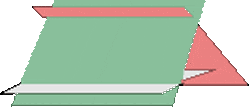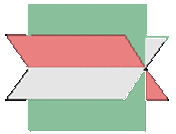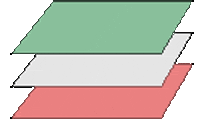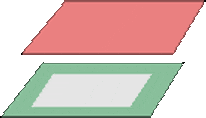How to Draw 3 Planes Intersecting at One Line
The current research tells us that at that place are 4 dimensions. These four dimensions are, 10-plane, y-plane, z-aeroplane, and time. Since we are working on a coordinate arrangement in maths, we volition exist neglecting the fourth dimension dimension for now. These planes tin intersect at whatsoever time at whatever identify. In that location is no definite saying that whether they all will intersect or some of them volition or mayhap none of them might intersect each other. The question is how to identify whether planes are intersecting with each other? Allow's figure it out!
Intersection of Planes
The best and possible style to larn about their intersection is using the rank method. Beneath is a small matrix of 3 planes.

To report the intersection of three planes, grade a organization with the equations of the planes and calculate the ranks.
r = rank of the coefficient matrix.
r'= rank of the augmented matrix.
There is a lot of possibilities for plane intersections. That is why we listed all kinds of possibilities and their identifications. The human relationship between the three planes presents can exist described every bit follows:

The best Maths tutors available
1. Intersecting at a Signal
When all three planes intersect at a single point, their rank of the coefficient matrix, every bit well as the augmented matrix, will exist equal to 3.
r=3, r'=iii

two.1 Each Plane Cuts the Other Two in a Line.
So you take learned almost a single point, what if it was a line? And there might be a chance of ii lines intersection too. This blazon of intersection will create a prismatic surface. The rank of the coefficient matrix will be two, nevertheless, the rank of the augmented matrix will be equal to three.
r = 2, r' = 3

two.two Two Parallel Planes and the Other Cuts Each in a Line
Same line scenario just a unmarried airplane cuts both parallels planes making a line intersection. The rank of the coefficient matrix will exist two while the rank of the augmented matrix will exist 3.
r = 2, r' = three
Two rows of the coefficient matrix are proportional. This is an identification of two parallel planes and the other cuts each in a line.
![]()

iii.one Iii Planes Intersecting in a Line
At that place is a possibility that all three planes will intersect each other but not at a sure indicate but on the line. This can happen and the best manner for its identification is that if the rank of the coefficient matrix, as well every bit the augmented matrix, is equal to ii.
r = 2, r' = 2

iii.2 Two Ancillary Planes and the Other Intersecting Them in a Line
If 2 planes are coincident and the 3rd plane is intersecting in a fashion that it creates a line then their rank of the coefficient matrix, as well as the augmented matrix, will also exist equal to two only with a twist. The ii rows of the augmented matrix will be proportional.
![]()
r = 2, r' = 2

4.1 Iii Parallel Planes
What if none of those planes intersects at any bespeak but they are parallel? And then their rank of the coefficient matrix volition be one, however, the rank of the augmented matrix will exist 2.
r = 1, r' = 2

4.2 Two Coincident Planes and the Other Parallel
If ii planes are coincided and the third 1 is parallel then the rank volition be the aforementioned, the rank of the coefficient matrix will exist one while the rank of the augmented matrix volition be 2. However, the signal to notice is that the two rows of the augmented matrix will exist proportional, which is the indication that you are working with two ancillary planes while the other plane is parallel.
![]()
r = 1, r' = two

5. Iii Coincident Planes
Concluding but not least, are all 3 planes coincident? Not an consequence! Both ranks, rank of the coefficient matrix as well as rank of the augmented matrix, will exist equal to 1.
r = 1, r' = 1

Examples
State the relationship between the three planes.
1. 



Each plane cuts the other two in a line and they form a prismatic surface.
2. 



Each program intersects at a signal.
3. 



![]()
The second and third planes are coincident and the first is cuting them, therefore the iii planes intersect in a line.
four. 



![]()
The get-go and 2nd are coincident and the third is parallel to them.
Source: https://www.superprof.co.uk/resources/academic/maths/geometry/plane/intersection-of-three-planes.html










0 Response to "How to Draw 3 Planes Intersecting at One Line"
Postar um comentário